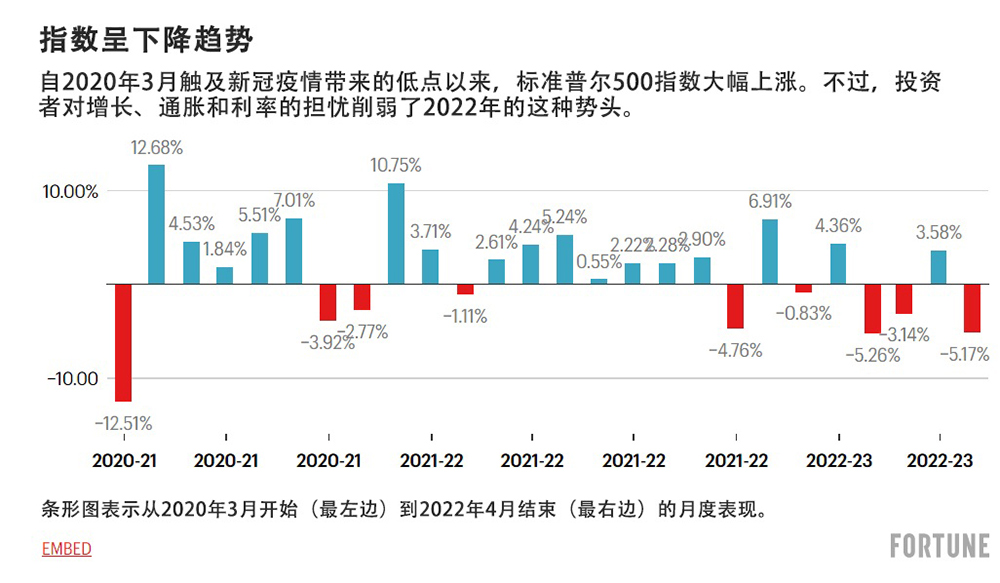在4月25日下午的尾盘交易中,在科技股的带动下,标准普尔500指数(S&P 500)有所回弹,总算是在连续四天的败退后稍稍稳住阵脚。很多美股投资者都在猜测这是否是股市回暖的信号,但华尔街却认为,大家最好还是别指望它。
尽管4月25日有所提振,但表现却相当分裂。早盘基准指数一度下跌了1.7%,直到临近午饭时间才有买家入场。但到全天尘埃落定,标准普尔500指数收涨24.34点,涨幅为0.6%。需要说明的是,甚至在推特(Twitter)的董事会确认将把公司出售给世界首富埃隆·马斯克之前,这股涨势就已经开始了。
从今年4月初到现在,标准普尔指数(S&P)已经跌了5.17%,仅以跌幅算,已经逼近2020年3月美国新冠疫情爆发以来的单月最差成绩。
德意志银行(Deutsche Bank)的研究策略师吉姆·里德在4月26日上午的一份投资者报告中写道:“如果标准普尔指数跌破今年1月-5.26%的纪录,那它就将成为新冠疫情以来美股跌得最惨的一个月,而且这种风险仍然是存在的。”

截至4月25日收盘,标准普尔指数已经较今年年初下跌10%,逼近调整区间。纳斯达克指数(Nasdaq)跌得更惨,科技板“四大牛股”Facebook、苹果(Apple)、Netflix、谷歌(合称FANG)光上周一周就跌了9%。
到目前为止,虽然各大上市公司一季度财报的数字都十分亮眼,但华尔街普遍认为当前的股市尚未见底。
比如,摩根士丹利财富管理公司(Morgan Stanley Wealth Management)的首席投资官丽莎·谢利特认为,股民的苦日子还在前头。“投资者可能认为通胀即将见顶,目前美国企业收益增长强劲,而且目前没有更好的投资工具能够替代美国证券市场。但是在我们看来,熊市还没有结束。”
谢利特的熊市预期可以说代表了摩根士丹利的悲观态度。在4月25日的另一份报告中,摩根士丹利的策略师们也使用了几乎同样的语言,指出标准普尔指数还将进一步下跌。迈克尔·威尔逊带领的证券策略团队指出:“标准普尔500指数似乎已经做好了进入熊市的准备。”
期货市场同样面临压力
截至4月26日,美国的期货市场仍然面临较大压力。截至美东时间上午5点,标准普尔期货指数下跌0.3%。此外还有两个投资者的看跌信号——作为“避险港”的美元和黄金期货都在升值。
而在大西洋彼岸,欧洲股市在经历了4月25日的大跌之后大多开始走高。而亚洲股市的表现则参差不齐,上证综指不出意料地继续“跌跌不休”。
华尔街也在寻找任何看跌情绪即将转变的迹象。基金的动向一直是一个被密切关注的指标,不过目前看来,机构们仍然觉得形势尚未好转。
高盛集团指出,上周,全球证券市场资金净流入为负,这标志着全球股市已经连续两周出现资金出逃。这期间,股市资金的出逃规模达到300亿美元,这也是自2020年第一季度以来最大规模的资金出逃事件。(财富中文网)
译者:朴成奎
在4月25日下午的尾盘交易中,在科技股的带动下,标准普尔500指数(S&P 500)有所回弹,总算是在连续四天的败退后稍稍稳住阵脚。很多美股投资者都在猜测这是否是股市回暖的信号,但华尔街却认为,大家最好还是别指望它。
尽管4月25日有所提振,但表现却相当分裂。早盘基准指数一度下跌了1.7%,直到临近午饭时间才有买家入场。但到全天尘埃落定,标准普尔500指数收涨24.34点,涨幅为0.6%。需要说明的是,甚至在推特(Twitter)的董事会确认将把公司出售给世界首富埃隆·马斯克之前,这股涨势就已经开始了。
从今年4月初到现在,标准普尔指数(S&P)已经跌了5.17%,仅以跌幅算,已经逼近2020年3月美国新冠疫情爆发以来的单月最差成绩。
德意志银行(Deutsche Bank)的研究策略师吉姆·里德在4月26日上午的一份投资者报告中写道:“如果标准普尔指数跌破今年1月-5.26%的纪录,那它就将成为新冠疫情以来美股跌得最惨的一个月,而且这种风险仍然是存在的。”
截至4月25日收盘,标准普尔指数已经较今年年初下跌10%,逼近调整区间。纳斯达克指数(Nasdaq)跌得更惨,科技板“四大牛股”Facebook、苹果(Apple)、Netflix、谷歌(合称FANG)光上周一周就跌了9%。
到目前为止,虽然各大上市公司一季度财报的数字都十分亮眼,但华尔街普遍认为当前的股市尚未见底。
比如,摩根士丹利财富管理公司(Morgan Stanley Wealth Management)的首席投资官丽莎·谢利特认为,股民的苦日子还在前头。“投资者可能认为通胀即将见顶,目前美国企业收益增长强劲,而且目前没有更好的投资工具能够替代美国证券市场。但是在我们看来,熊市还没有结束。”
谢利特的熊市预期可以说代表了摩根士丹利的悲观态度。在4月25日的另一份报告中,摩根士丹利的策略师们也使用了几乎同样的语言,指出标准普尔指数还将进一步下跌。迈克尔·威尔逊带领的证券策略团队指出:“标准普尔500指数似乎已经做好了进入熊市的准备。”
期货市场同样面临压力
截至4月26日,美国的期货市场仍然面临较大压力。截至美东时间上午5点,标准普尔期货指数下跌0.3%。此外还有两个投资者的看跌信号——作为“避险港”的美元和黄金期货都在升值。
而在大西洋彼岸,欧洲股市在经历了4月25日的大跌之后大多开始走高。而亚洲股市的表现则参差不齐,上证综指不出意料地继续“跌跌不休”。
华尔街也在寻找任何看跌情绪即将转变的迹象。基金的动向一直是一个被密切关注的指标,不过目前看来,机构们仍然觉得形势尚未好转。
高盛集团指出,上周,全球证券市场资金净流入为负,这标志着全球股市已经连续两周出现资金出逃。这期间,股市资金的出逃规模达到300亿美元,这也是自2020年第一季度以来最大规模的资金出逃事件。(财富中文网)
译者:朴成奎
April 25's late-afternoon tech-led rebound pushed the S&P 500 into the green, enough to break a four-day losing streak. Could it be a sign of things to come? Don't count on it, Wall Street says.
Even with April 25's uplifting performance for equities, there were plenty of Jekyll and Hyde moments. At its worst, the benchmark was down 1.7% midmorning, only for the buyers to show up around lunchtime. When the dust settled, the S&P closed up by 24.34 points, or 0.6%. Incidentally, the rally started even before the board of Twitter confirmed it had agreed to sell the social media platform to the world's richest man, Elon Musk.
Even with yesterday's positive showing, the S&P is down 5.17% in April, dangerously close to posting its worst monthly performance since March 2020—i.e., the nadir of the COVID collapse in equities.
As Deutsche Bank research strategist Jim Reid wrote in an investor note this morning, the S&P is “still at risk of taking the ignominious title of worst monthly return since COVID if it dips below this January’s -5.26% return.”
As of April 25's close, the S&P was hovering around correction territory year to date, or down 10%. The Nasdaq has fared even worse, with once high-flying FANG stocks sinking nearly 9% last week alone.
So far, few on Wall Street are ready to call a bottom even as corporate earnings season continues to generate a surprisingly strong number of bottom-line beats.
Lisa Shalett, chief investment officer of Morgan Stanley Wealth Management, was the latest one to warn investors of more pain ahead. "Investors seem to be banking on peaking inflation, strong earnings growth, and that there is no good alternative to U.S. equities. In our view, the bear market is not over," she said.
Shalett's bearish call underscores deeper pessimism at Morgan Stanley. In a separate note on April 25, strategists at the investment bank used almost identical language to say the S&P has further to fall. “The S&P 500 appears ready to join the ongoing bear market,” wrote the equities strategy team led by Michael J. Wilson.
Futures under pressure
On April 26, U.S. futures remained under pressure. At 5 a.m. ET, S&P futures were down 0.3%, off earlier modest gains. A further signal of investor bearishness: the safe-haven dollar was gaining, as were gold futures.
Across the Atlantic, the European bourses were mostly higher, after a rough April 25 selloff. Asian stocks were mixed, with Shanghai Composite again deep in the red.
Wall Street is looking for any indication the bearish mood will shift. One indicator, closely watched fund flow data, shows zero relief.
According to Goldman Sachs, net flows into global equity funds were negative last week for a second consecutive week. Over that span, investors pulled $30 billion out of equity funds, the largest pullout since the first quarter of 2020—again, when COVID jitters were clobbering the markets.






